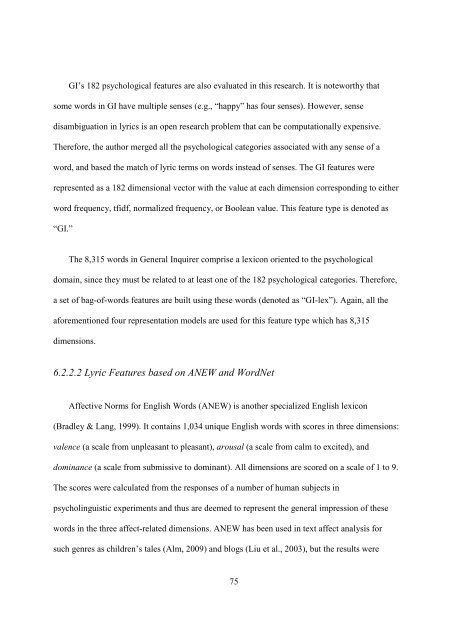improving music mood classification using lyrics, audio and social tags
improving music mood classification using lyrics, audio and social tags
improving music mood classification using lyrics, audio and social tags
You also want an ePaper? Increase the reach of your titles
YUMPU automatically turns print PDFs into web optimized ePapers that Google loves.
GI’s 182 psychological features are also evaluated in this research. It is noteworthy that<br />
some words in GI have multiple senses (e.g., “happy” has four senses). However, sense<br />
disambiguation in <strong>lyrics</strong> is an open research problem that can be computationally expensive.<br />
Therefore, the author merged all the psychological categories associated with any sense of a<br />
word, <strong>and</strong> based the match of lyric terms on words instead of senses. The GI features were<br />
represented as a 182 dimensional vector with the value at each dimension corresponding to either<br />
word frequency, tfidf, normalized frequency, or Boolean value. This feature type is denoted as<br />
“GI.”<br />
The 8,315 words in General Inquirer comprise a lexicon oriented to the psychological<br />
domain, since they must be related to at least one of the 182 psychological categories. Therefore,<br />
a set of bag-of-words features are built <strong>using</strong> these words (denoted as “GI-lex”). Again, all the<br />
aforementioned four representation models are used for this feature type which has 8,315<br />
dimensions.<br />
6.2.2.2 Lyric Features based on ANEW <strong>and</strong> WordNet<br />
Affective Norms for English Words (ANEW) is another specialized English lexicon<br />
(Bradley & Lang, 1999). It contains 1,034 unique English words with scores in three dimensions:<br />
valence (a scale from unpleasant to pleasant), arousal (a scale from calm to excited), <strong>and</strong><br />
dominance (a scale from submissive to dominant). All dimensions are scored on a scale of 1 to 9.<br />
The scores were calculated from the responses of a number of human subjects in<br />
psycholinguistic experiments <strong>and</strong> thus are deemed to represent the general impression of these<br />
words in the three affect-related dimensions. ANEW has been used in text affect analysis for<br />
such genres as children’s tales (Alm, 2009) <strong>and</strong> blogs (Liu et al., 2003), but the results were<br />
75
















